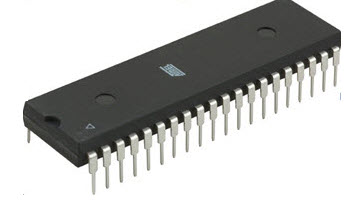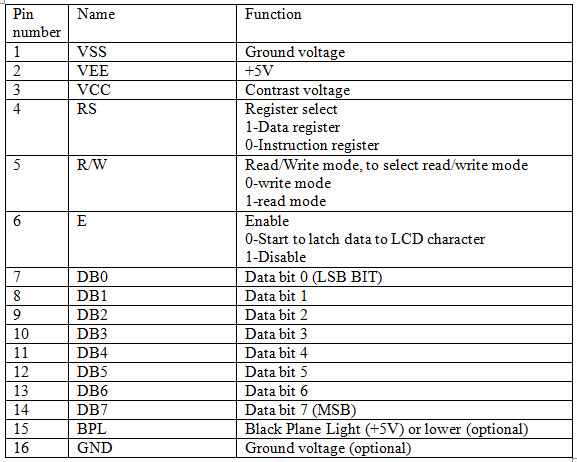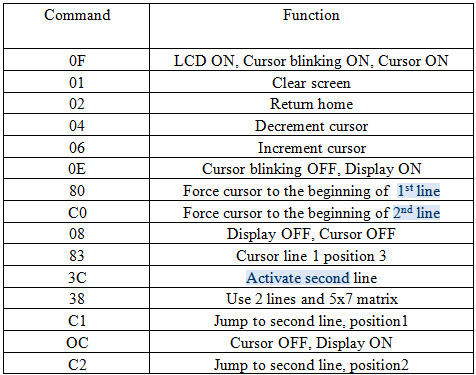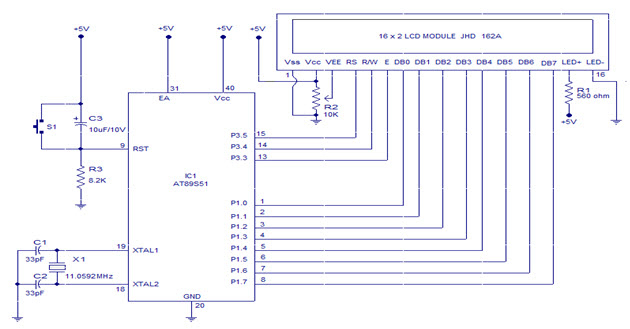A decade back the process and control
operations were totally implemented by using the microprocessor only.
But now-a-days the situation is totally changed and it is occupied by
the new device called Microcontroller. We can’t find any electronic
gadget without the use of a Microcontroller because the development is
so drastic. The Microcontroller has changed the embedded system design so simple and advanced.
LCD’s use two sheets of polarizing
material with a liquid crystal solution placed between them. When
electric current passed through the crystal solution, the crystals get
aligned so that light cannot pass through them. Each crystal is thus
like a shutter, either allowing light to pass through or block it. There
are two kinds of LCD such as color and monochrome. For projects we use
monochrome, while for TV, Laptops we use color. Color LCD uses two basic
techniques for producing color. This article discusses about LCD interfacing with 8051 microcontroller.
What is a Microcontroller?
A Microcontroller is a small computer in
an integrating circuit which contains memory, programmable input and
output peripherals, processor core. Microcontroller primarily designed
for embedded applications
while Microprocessor designed for personal computers or general purpose
applications. Microcontroller instructions are both bit addressable as
well as byte addressable. It has instruction sets catering to the
control of inputs and outputs.

8051 Microcontroller
LCD Interfacing Module Review
16×2 LCD module is a very common type of LCD module to be used in 8051 based embedded projects.
It has 16 rows and 2 columns [5×7] or [5×8] LCD dot matrices. The
module we will use is number JHD162A. Available in 16 pin packages with
features like contrast adjustment function, back light and each dot
matrix has 5×8 dot resolution.
The pin numbers, their name and functions are shown in the table below

- VEE pin 3 adjusts the contrast of the LCD display by varying voltage at this pin. Performed by connecting one end to ground potential and other to VCC (5V).
- R/W pin 5 selects between read and write modes. LOGIC HIGH at pin facilitates READ mode and LOW level on this pin facilitates WRITE mode.
- JHD162A has 2 inbuilt registers. Logic High (1) at RS pin 4 selects the data register. Inserts a data on the data line, the module will recognize it as a command. Logic Low (0) logic at the RS pin will select the command register.
- Data register- place the data to be displayed
- Command register- places the commands. Inserts data in 8 bit data line (DB0 to DB7), the LCD module recognizes it as data to be displayed
- E pin 6 turns on the module. A high to low transition on this pin will switch on the module.
- DB0 to DB7 are data pins. The data to be displayed and the command instructions are placed on these pins.
- LED (+) is the backlight, LED anode and this pin must be connected to Vcc through a series current limiting resistor of appropriate value. LED (-) is the backlight, LED cathode and this pin must be connected to ground.
- 16×2 LCD module commands
16×2 LCD module contains set of preset
command instructions. Each command will make the module to do a
particular task. The commonly used function and their commands are given
in the table below.

LCD Initialization
For initializing the LCD display, the
following are the steps which are given below and these steps are same
for almost all the applications.
- Send 38H to the 8-bit data line for initialization
- Send 0FH for making LCD ON, cursor ON, cursor blinking ON
- Send 06H for incrementing cursor position
- Send 01H for clearing the display and return the cursor
Sending Data to the LCD
The following are the steps for sending
the data the LCD module which is given below. The logic state of these
pins that make the module to determine whether a given data input is a
data or command to be displayed.
- Make R/W low
- Make RS=1, if the data byte is a data to be displayed and make
- RS=0, if data byte is a command.
- Place data byte on the data register
- Then pulse E from high to low
- Repeat above steps for sending other data
Circuit Diagram of LCD interfacing of 8051 Microcontroller
The circuit diagram of Interfacing 16×2
LCD module with AT89S51 Microcontroller is as shown above. Resistor R3,
Capacitor C3 and push button switch S1 will form the reset circuitry.
Crystal X1 and ceramic capacitors C1, C2 is related to the clock
circuitry which will produce the system clock frequency. P1.0 to P1.7
pins of the microcontroller is connected to the module DB0 to DB7 pins
respectively, this route the data which go to the LCD module. P3.3, P3.3
and P3.5 connect to the E, R/W, RS pins of microcontroller and this
route the control signals which are transferred to the LCD module. R1
resistor limits the current through the LED backlight and the backlight
intensity. POT R2 is used for adjusting the contrast of the display. The
program for interfacing LCD with 8051 microcontroller is as shown
below.

LCD Interfacing Circuit Diagram
Program for LCD interfacing to 8051 Microcontroller
MOV A, #38H / / Use 2 lines and 5×7 matrix
ACALL CMND
MOV A, #0FH / / LCD ON, cursor ON, cursor blinking ON
ACALL CMND
MOV A, #06H / / Increment cursor
ACALL CMND
MOV A, #82H / / Cursor line one, position 2
ACALL CMND
MOV A, #3CH / / Activate second line
ACALL CMND
MOV A, #49D
ACALL DISP
MOV A, #54D
ACALL DISP
MOV A, #88D
ACALL DISP
MOV A, #50D
ACALL DISP
MOV A, #32D
ACALL DISP
MOV A, #76D
ACALL DISP
MOV A, #67D
ACALL DISP
MOV A, #68D
ACALL DISP
MOV A, #0C1H / / Jump to second line, position 1
ACALL CMND
MOV A, #67D
ACALL DISP
MOV A, #73D
ACALL DISP
MOV A, #82D
ACALL DISP
MOV A, #67D
ACALL DISP
MOV A, #85D
ACALL DISP
MOV A, #73D
ACALL DISP
MOV A, #84D
ACALL DISP
MOV A, #84D
ACALL DISP
MOV A, #83D
ACALL DISP
MOV A, #84D
ACALL DISP
MOV A, #79D
ACALL DISP
MOV A, #68D
ACALL DISP
MOV A, #65D
ACALL DISP
MOV A, #89D
ACALL DISP
HERE: SJMP HERE
CMND: MOV P1, A
CLR P3.5
CLR P3.4
SETB P3.3
CLR P3.3
ACALL DELY
RET
DISP: MOV P1, A
SETB P3.5
CLR P3.4
SETB P3.3
CLR P3.3
ACALL DELY
RET
DELY: CLR P3.3
CLR P3.5
SETB P3.4
MOV P1, #0FFh
SETB P3.3
MOV A, P1
JB ACC.7, DELY
CLR P3.3
CLR P3.4
RET
END
ACALL CMND
MOV A, #0FH / / LCD ON, cursor ON, cursor blinking ON
ACALL CMND
MOV A, #06H / / Increment cursor
ACALL CMND
MOV A, #82H / / Cursor line one, position 2
ACALL CMND
MOV A, #3CH / / Activate second line
ACALL CMND
MOV A, #49D
ACALL DISP
MOV A, #54D
ACALL DISP
MOV A, #88D
ACALL DISP
MOV A, #50D
ACALL DISP
MOV A, #32D
ACALL DISP
MOV A, #76D
ACALL DISP
MOV A, #67D
ACALL DISP
MOV A, #68D
ACALL DISP
MOV A, #0C1H / / Jump to second line, position 1
ACALL CMND
MOV A, #67D
ACALL DISP
MOV A, #73D
ACALL DISP
MOV A, #82D
ACALL DISP
MOV A, #67D
ACALL DISP
MOV A, #85D
ACALL DISP
MOV A, #73D
ACALL DISP
MOV A, #84D
ACALL DISP
MOV A, #84D
ACALL DISP
MOV A, #83D
ACALL DISP
MOV A, #84D
ACALL DISP
MOV A, #79D
ACALL DISP
MOV A, #68D
ACALL DISP
MOV A, #65D
ACALL DISP
MOV A, #89D
ACALL DISP
HERE: SJMP HERE
CMND: MOV P1, A
CLR P3.5
CLR P3.4
SETB P3.3
CLR P3.3
ACALL DELY
RET
DISP: MOV P1, A
SETB P3.5
CLR P3.4
SETB P3.3
CLR P3.3
ACALL DELY
RET
DELY: CLR P3.3
CLR P3.5
SETB P3.4
MOV P1, #0FFh
SETB P3.3
MOV A, P1
JB ACC.7, DELY
CLR P3.3
CLR P3.4
RET
END
This is all about LCD interfacing with 8051 microcontroller.
We believe that the information given in this article is helpful for
you for better understanding of this project. Furthermore, any queries
regarding this article or any help in implementing the electrical and electronics projects,
you can feel free to approach us by connecting in the comment section
below. Here is a question for you, what is the code for LCD interfacing
with 8051 microcontroller?






No comments:
Post a Comment